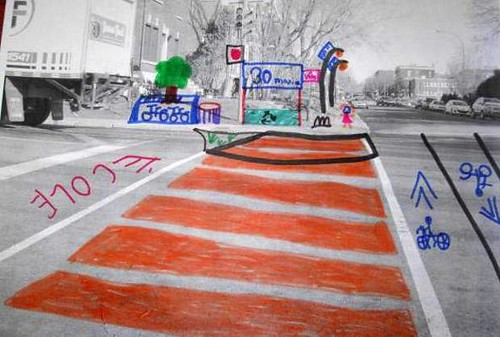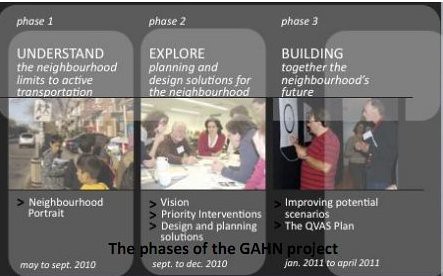Planning for sustainable transportation at the neighborhood level in Montreal

The Montreal Urban Ecology Center has an interesting initiative, "Green, Active and Healthy Neighbourhoods," which aims to redesign neighbourhoods to promote walking, cycling, and other active transportation modes. The four pilot projects are in the neighborhoods of Mercier Extension, Plateau East, Southeastern Notre Dame de Grace, and Parc Extension.
The initiative is a true implementation of my idea to create "sustainable transportation elements" for community and sector plans, focused not just on infrastructure but also including programming.
From the draft Western Baltimore County Pedestrian and Bicycle Master Plan:
Modify the process for creating community plans to include a “sustainable transportation” element as a standard section, covering walking,bicycling, and transit. This element should cover programming opportunities as well as facilities recommendations. (page 72)
One of the many programming activities in the process is to work with school-aged children. A lot of the time I find children-focused planning exercises to be more cute and focused on maximizing engagement but at the expense of substance (e.g. in a number of the projects at the National Building Museum, children and youth recommend that neighborhoods need McDonald's fast food restaurants and shopping malls) because apparently they don't start with a basic exploration of good vs. bad planning principles.

There are three phases in the Green and Healthy Neighborhoods planning process.
An article in the Winter 2011 issue of Urbanité, the publication of the Quebec Planners Association, "Changing the city, one neighbourhood at a time" (translated from the French) discusses the initiative and describes the three phase framework for the planning process:
Phase one examines active transportation in the neighbourhood in order to target problems or possibilities related to mobility. Different data collection methods are used to create a neighbourhood portrait. The local committee produces certain sections of the neighbourhood portrait including a neighbourhood history, a report on the participatory culture of citizens and community actors, and a neighbourhood profile, all of which help particularly to enrich the GAHN process.
Phase two establishes a common vision, defines intervention priorities, and creates [urban appropriate] design solutions that respect the local identity and practices of the neighbourhood.
In the third phase, design scenarios are submitted to different partners who approve them and make any necessary changes before integrating them into the GAHN Plan. The Plan itself has three chapters. The first describes the general initiative, the second presents the neighbourhood portrait, and the third presents proposed courses of action. Although the Plan mainly addresses the local government, it also addresses the City of Montréal, transit agencies and companies, and upper levels of government, as well as community institutions, merchants, and individuals.
Sounds like a pretty good method to me. Most of the documents for the various projects are in French, which we'll have to bone up on in order to delve more deeply into the project...
Labels: neighborhood change, neighborhood planning, neighborhood-based transportation planning, transportation planning, urban design/placemaking, urban revitalization



0 Comments:
Post a Comment
<< Home